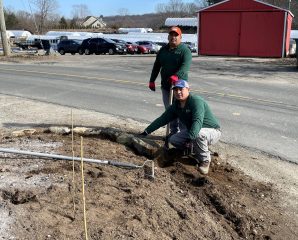As part of the planting plan for around the Planters’ Choice sign that we created in Step 3, we intended to put new plants in the entire area from the maple tree to the road and from the driveway to the parking lot. This meant removing all of the existing grass, which Serbio and Saul helped with, and digging up the bulbs to be replanted after the soil was amended. Serbio and Saul also thought it was a good idea to add a stone wall on the side near the road to keep the soil in place and deter trucks from driving over the corner of the bed. So they helped with that as well. Once that was done it was time to add the amendments. Our calculation for the area was a little more than 250 square feet. So this is the number we used to calculate the amount of amendments needed.
Going back to the soil test results that we shared in Step 1, we know we need to raise the pH of the soil and that Calcium and Potassium are not at optimal levels. In order to raise the pH, UCONN’s soil test recommended adding 15 lbs of limestone per 100 sf. Since our area is approximately 250 sqft we multiply this number by 2.5 to get 37.5 lbs of limestone needed. Lime comes in different forms known as calcitic lime, dolomitic lime, burned lime, and hydrated lime. All of them contain calcium, so by adding lime to the soil it will also help to increase the level of Calcium. Dolomitic lime also contains Magnesium so it can be beneficial when the soil has a low level of Magnesium as well. From experience I know that there is another way to raise the pH of soil and that is with wood ash. The soil test doesn’t have any recommendations for wood ash, so I looked elsewhere for those rates. Olivia Saunders has a nice article on wood ash from UNH Cooperative Extension System. It recommends adding 20 lbs of wood ash per 1,000 sf. If we divide this number by 4 we get the amount needed for our 250 sf area – 5 lbs. Since wood ash was available and free and adds additional nutrients, I chose to use it as an amendment. A digital scale is how I guarantee to get the right amount of an amendment. First a bucket was weighed and then the 5 pounds of ash that was added to the bucket. The ash was broadcast by hand over the area and cultivated it into the soil.
The second recommendation from the soil test was to add a fertilizer to help increase the Potassium level in the soil. For the planting of the bulbs I chose to use Bulb-Tone, which has an N-P-K ratio of 3-5-3. It also contains 6% Calcium and some Magnesium and Sulfur – all six of these elements are macronutrients. After doing some math I determined that the directions on the bag recommend applying about the equivalent amount of actual Potassium as the soil test recommendations. I broadcast this by hand over the area being planted using a measuring cup, since the direction’s unit of measure was cups or pounds. Once the fertilizer was cultivated into the soil we were ready to put the bulbs in the ground, which will be discussed in Step 5.

